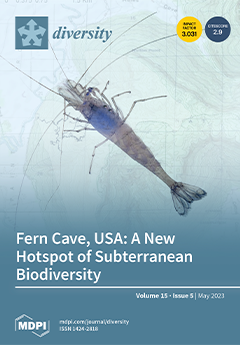A new species of the genus
Niphargus Schiödte, 1849 (Crustacea: Amphipoda: Niphargidae), co-existing with other stygobiotic amphipods,
Diasynurella kiwi Marin and Palatov, 2023 and
Pontonyx donensis (Martynov, 1919) (Crangonyctidae), is described from a small spring on a shore of Kiziterinka River in Rostov-on-Don
[...] Read more.
A new species of the genus
Niphargus Schiödte, 1849 (Crustacea: Amphipoda: Niphargidae), co-existing with other stygobiotic amphipods,
Diasynurella kiwi Marin and Palatov, 2023 and
Pontonyx donensis (Martynov, 1919) (Crangonyctidae), is described from a small spring on a shore of Kiziterinka River in Rostov-on-Don City in the mouth of the Don River. Two of the three species in the studied spring,
D. kiwi and the discovered
Niphargus, belong to microcrustaceans not exceeding the total body size of 3 mm. The new species,
Niphargus rostovi sp. nov., represents one of the smallest species within the genus and is mostly related to the Greek
Niphargus karkabounasi Ntakis, Anastasiadou, Zakšek and Fišer, 2015, which is also not reaching the body size of 3 mm. One more related undescribed species is found on the Crete Island by the molecular genetic data. These species represent a separate phylogenetic lineage within the “
carpathicus” species complex, which diverged from the congeners in the Late Miocene for more than 10 Mya. At the same time, the speciation within the ingroup started about 5–6 Mya, obviously correlating with the drainage of the Euxinian basin of the Eastern Paratethys, connecting the lower Don and southern Greece areas.
Niphargus potamophilus Birštein, 1954 is also first recorded from the mouth of the Belbek River in the Crimean Peninsula, closing the known area from the Kuban River delta to Rostov-on-Don area and further along the western coast of the Black Sea to Bulgaria. Analysis of the recent records of long-time lineages of endemic/subterranean/stygobiotic animals unable to disperse for long distances assumed that glacial refugium existed at the mouth of the Don River, along with the South Caucasus (Colchis) and the southern Caspian (Hyrcania), where many species have survived several periods of glaciation since the late Miocene.
Full article





